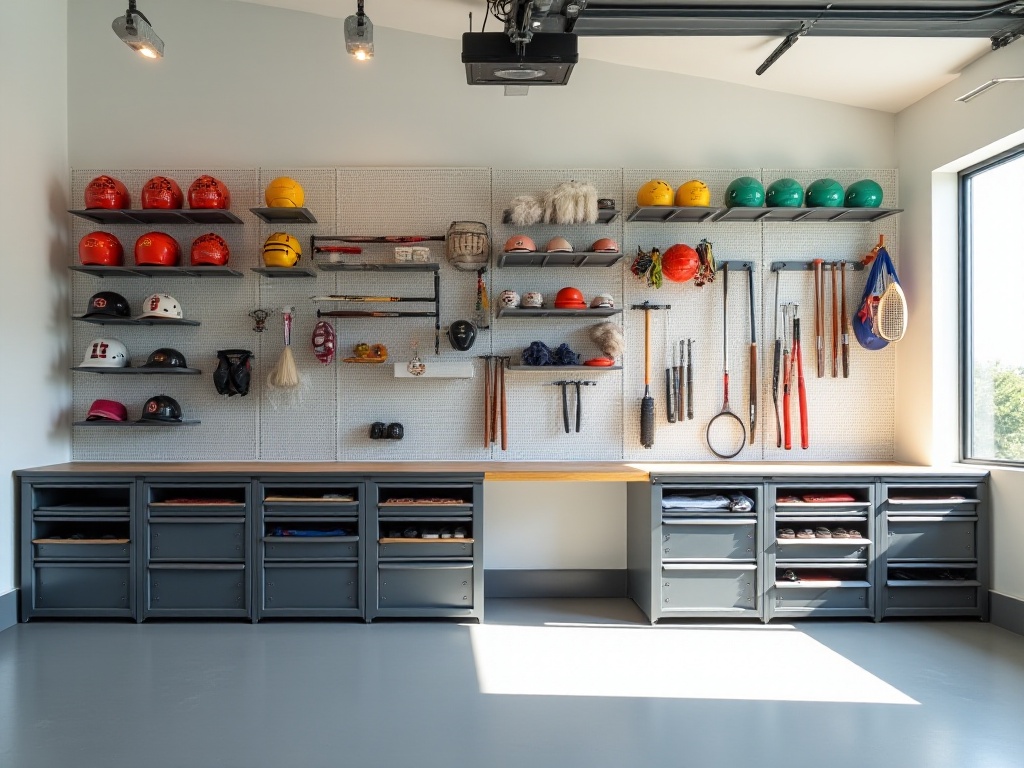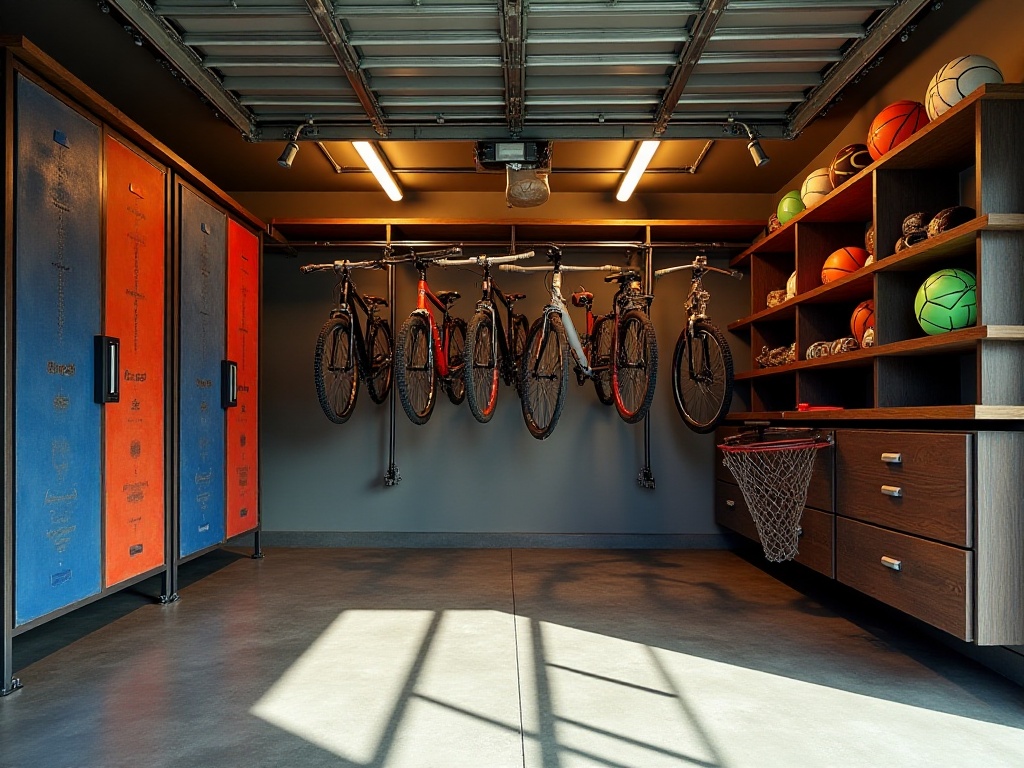Introduction
Do you have this problem too? Dropping your exercise equipment randomly when you get home, leaving sports items scattered in every corner of your house. A basketball in the entryway, yoga mat by the sofa, dumbbells scattered under the bed... This not only affects the aesthetics of your home environment but more importantly dampens your motivation to exercise. In fact, organizing exercise equipment isn't just about keeping your home tidy - it reflects your quality of life. A well-planned storage space for exercise equipment can help systematize your workout routine and make exercise a beautiful part of your lifestyle. Today, let me share how to organize messy exercise equipment neatly and make working out the most anticipated part of your day.
Store Vertically
I remember when I first started working out, the exercise equipment in my home was a nightmare. The yoga mat would never stay rolled up in the corner, resistance bands tangled like yarn, dumbbells scattered everywhere - I had to walk carefully to avoid them. Until one day, I discovered an incredibly useful trick - make good use of wall space. Storing things vertically not only saves space but makes the home look tidier. This discovery completely changed my storage approach, turning what was once a messy exercise corner into an attractive feature.
In my home, I divided the wall into several zones. A yoga zone for mats and balls, strength training zone for dumbbells and resistance bands, and cardio zone for jump ropes and other small equipment. Each zone has adjustable hooks and storage racks so I can flexibly arrange based on equipment size. I especially love the adjustable hook system because it's not only sturdy but allows me to adjust height and spacing as needed. For yoga mats, I chose a dedicated vertical storage rack that keeps mats flat and prevents deformation. The yoga ball is secured to the wall in a special net bag, saving space while keeping it accessible.
Did you know? A 1 square meter wall space, when properly planned, can store exercise equipment worth tens of thousands. Best of all, when this equipment is displayed on the wall like artwork, it becomes an attractive feature. My wall storage area often receives compliments from guests who say this arrangement is both practical and well-designed, transforming exercise equipment into part of the home decor.
To make the wall storage more aesthetically pleasing, I deliberately chose storage racks and hooks in a unified style. Black metal material paired with natural wood storage racks creates a modern yet warm look. I also installed spotlights above the storage area - at night when lit up, the entire wall becomes like a carefully curated display area that motivates you to exercise.
For smaller equipment like grip strengtheners and foam rollers, I installed covered storage boxes on the wall. These boxes keep out dust while maintaining a tidy space. The transparent design lets me find equipment at a glance. I also labeled each storage box so things don't get misplaced.

Mobile Solutions
For exercise equipment that needs to be carried around frequently, I have a completely different storage solution. This system was developed through multiple adjustments and refinements, considering not just portability but also practicality and tidiness.
First is my gym bag organization method. I divide the bag into three zones: wet zone for towels and change of clothes, dry zone for protective gear and equipment, and small items zone for keys and phone. With this categorization, I no longer worry about sweaty clothes dampening other items. To make the zones more distinct, I use different colored storage bags - red for wet, blue for dry, yellow for small items. This makes it easy to find things even in poor lighting.
For gym bag selection, I especially recommend those with shoe compartment designs. This allows separate storage of shoes from other items - both hygienic and practical. The bag should ideally have a water bottle holder on the side for easy hydration. The top should have an easily accessible small pocket for frequently used items like headbands and sports watches.
An important reminder - many people overlook car storage. As someone who frequently plays basketball, I keep a multi-function storage box in my car. It holds not just balls and protective gear but has an insulated section for drinks and energy bars. This way, I'm prepared whether for impromptu games or planned training. I chose a foldable car storage box that can be collapsed when not in use to save space. The compartments are adjustable to flexibly accommodate different sized equipment.
To keep the car storage box tidy, I clean it out weekly. I remove unnecessary items and bring equipment that needs washing home. This maintains clean equipment and helps identify what needs replacement or repair.
For frequently replaced items like towels and sports socks, I keep a backup pack in the car. This pack contains clean replacement gear for unexpected needs. I regularly check and update items in the backup pack to ensure everything is clean and usable.

Categorize by Type
When it comes to storage, classification is most important. My suggestion is to first categorize by sport, then subcategorize by frequency of use. This method helps you quickly find needed equipment while better managing and maintaining the gear.
Take my favorite basketball for example - I divide them into three categories: game balls, training balls, and casual balls. Game balls are kept in the most accessible spot, training balls in secondary positions, and rarely used balls can go in the storage room. I take special care of game balls, carefully wiping them after each use and regularly checking air pressure. Training balls are treated more casually but still kept clean and maintained.
Protective gear storage requires special attention. For small items like knee and wrist guards, I use transparent drawer storage boxes. This makes items easy to find while helping identify what needs washing or replacement. I categorize protective gear by body part - hand protection zone, foot protection zone, etc. Each zone is clearly labeled for convenience.
For precision electronic devices like heart rate monitors and smart bands, I have specially prepared shock-proof and moisture-proof storage boxes. These expensive devices need particular care. I keep manuals and accessories together in the box to avoid loss. Charging cables are also properly stored, preferably secured with cable organizers to prevent tangling.
Strength training equipment storage has its own considerations. Heavy equipment like dumbbells and kettlebells should be stored low - this is safer and more convenient. I place shock-absorbing mats where this equipment is stored to protect the floor and reduce noise. Lighter equipment like resistance bands and pull-up assists can be hung on walls or stored in drawers.
Yoga equipment storage requires special attention to dust and moisture prevention. Yoga mats are best stored vertically using dedicated racks. Small equipment like yoga blocks and straps can be kept in transparent storage boxes for dust protection and easy location. While yoga balls are bulky, they can be deflated for storage and re-inflated when needed.
Practical Advice
After all that theory, let's talk about practical implementation. To organize exercise equipment neatly requires thorough preparation and planning.
First, buy an adjustable wall storage rack system. There are many options on the market ranging from hundreds to thousands in price. I recommend choosing a system that can be freely combined, allowing flexible adjustment as equipment changes. When selecting a wall storage system, note several key points: weight capacity should be sufficient, preferably over 50kg; installation must be secure, ideally anchored at least 5cm into the wall; material should be durable, metal is recommended for long-lasting use without deformation.
Location choice for storage racks is also important. Choose well-lit, ventilated areas to prevent equipment from getting damp and moldy. If placing in living room or bedroom, consider aesthetics - try to coordinate with home decor style. Height from floor should be appropriate, with most-used equipment at easily reachable heights and less-used items higher up.
Second, prepare several transparent storage boxes. The advantage of transparent material is seeing contents at a glance, eliminating the need to search through everything. Choose box sizes based on equipment dimensions - too large wastes space, too small won't fit everything. Consider buying a set of coordinated sizes for flexible use.
Storage boxes should preferably have lids for dust and moisture protection. For equipment prone to moisture like towels or workout clothes, place some desiccant packets in the boxes. Choose eco-friendly, non-toxic materials since exercise equipment often contacts skin.
Finally, don't forget to label each zone. This helps maintain tidiness and encourages others to follow the organization system. Labels can be written on adhesive paper or printed with a label maker. Keep label content simple and clear, preferably in large font for easy reading.
After establishing the storage system, developing good usage habits is most important. Return equipment to its place after each workout, regularly check and clean equipment, and promptly replace damaged storage items. This maintains the system's long-term effectiveness.

Storage Mistakes
At this point, we must address several common storage mistakes. These mistakes not only affect storage effectiveness but may lead to equipment damage - a costly error.
Many people like stuffing all exercise equipment into one big box, thinking it's convenient. In reality, this makes finding things difficult and can damage equipment. Precision devices like heart rate monitors and smart bands especially should be stored separately. Mixed storage can cause scratches and functional damage from compression.
Some people store damp equipment directly. This is a major mistake that breeds bacteria and affects equipment lifespan. The correct approach is to dry equipment after use before storage. For items prone to odors like shoes or protective gear, spray with disinfectant after drying to maintain freshness and extend usability.
Some stack heavy items together to save space. While this seems space-efficient, it easily causes equipment deformation or damage. Especially plastic equipment can easily deform under pressure, affecting functionality. The correct approach is to arrange based on material and weight - heavy items below, light items above, with protective padding in between.
Another common mistake is ignoring storage environment importance. Many store exercise equipment on balconies or in storage rooms, areas often prone to moisture or direct sunlight. Over time, equipment easily molds or deteriorates. Choose well-ventilated, dry storage locations, and install a dehumidifier if possible.
Over-organization is also problematic. Some wrap equipment too tightly pursuing tidiness, making access difficult. The purpose of storage is convenience - if storage hinders use, it defeats the purpose. Find balance between protection and accessibility.

Conclusion and Outlook
Through these storage methods, my exercise equipment is no longer messy. More importantly, organized storage creates a positive, uplifting feeling - seeing neatly arranged exercise equipment motivates working out. This change affects not just the physical environment but influences lifestyle attitudes and habits.
Reasonable storage makes my exercise more regular and focused. When all equipment has a fixed place, I don't waste time searching. Moreover, seeing organized exercise equipment naturally inspires wanting to exercise - this visual motivation shouldn't be underestimated.
Have you noticed that when we start taking exercise equipment storage seriously, we're actually cultivating a lifestyle attitude? It's not just simple organization but a commitment to healthy living. Through carefully planning and maintaining exercise space, we're actually creating a better living environment for ourselves.
Establishing a storage system isn't accomplished overnight - it requires continuous adjustment and improvement. As exercise habits change and equipment varies, storage methods must evolve. Regular system checks and updates, timely adjustment of impractical aspects maintain long-term effectiveness.
Finally, I want to say there's no standard answer for storage - the key is finding what works for you. Everyone's living space and exercise habits differ, so storage methods naturally vary by individual. I hope sharing through this article helps you find your own storage solution.
Actually, exercise equipment storage isn't just an organization process but reflects life artistry. When your exercise space becomes neat and orderly, you'll find exercise itself becomes more enjoyable. This change not only improves quality of life but makes exercise a pleasure rather than burden.
Do you have unique storage methods? Welcome to share in the comments. Let's create clean, comfortable exercise spaces together, making exercise life's most beautiful habit.


